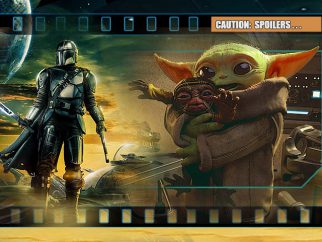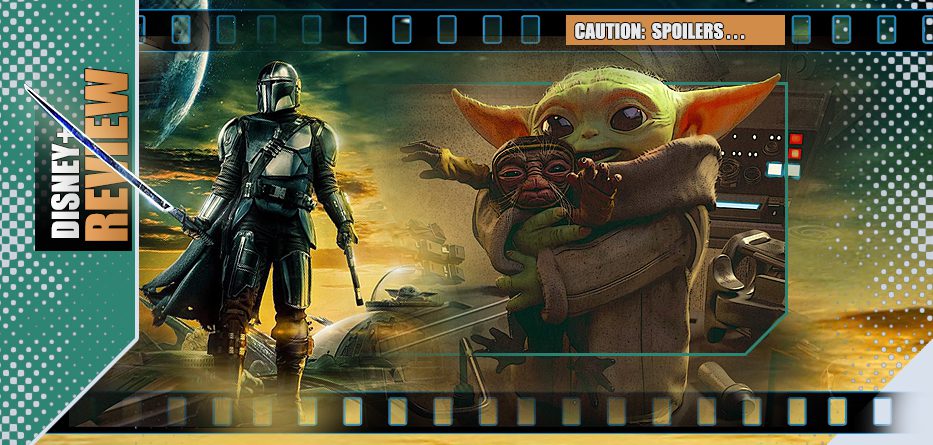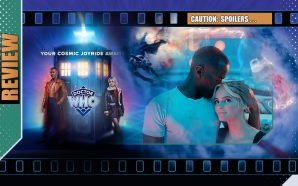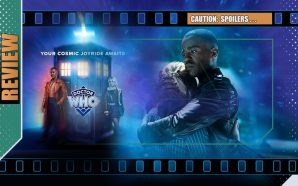Din Djarin, The Mandalorian, is still caring for Grogu, the fledgling Jedi who was being taught by Luke Skywalker. He has no regrets about travelling with the diminutive creature, but feels the shame of having removed his own warrior helmet to do so – something utterly forbidden by the warriors of Mandalore. Seeking redemption, he is told the only way is to bathe within the waters of Mandalore itself, but that is now reported to be a toxic planet, laid waste by the Empire.
If Djarin is even going to attempt to return to Mandalore he’s going to need a lot of help, possibly even some from a long ‘dead’ ally. He heads back to Nevarro to call in some favours, but for a Mandalorian there are always dangers and distractions…
*spoilers*
Pedro Pascal as a character who has to totally alter his routine and finds himself taking care of a miraculous young charge who seems to attract both interest and trouble in equal measures and making him feel like a surrogate father? Yeah… like that’s ever going to popular!
Joking aside, Pascal is certainly earning his reputation as the ‘Internet Daddy’ this week… he’ll be back as Joel in the last two episodes of The Last of Us (running on Sundays on SKY and HBO) but anyone needing a mid-week fix will likely return of The Mandalorian in which we swap out Ellie for Baby Yoda – or, rather, Grogu. The truth is I’ve always thought this was a rather thankless role for Pedro Pascal – one that’s so anonymous that the actor isn’t even the one we see on screen for half the running-time or more and the success of The Last of Us (and the way he plays Joel with such grizzled warmth and hurt) easily eclipses his work here, though the vocals are fine. But there are some joys in a simpler tale here, one populated by familiar mythological touchstones and that feels familiar if not that challenging.
What you think of The Mandalorian‘s return may ultimately rest on what you want from your Star Wars. Is it the original, rollickin’ adventures of the Saturday Matinee variety with derring-do, quests and some clear starlight between the good and the bad of the universe? Or do you want the more nuanced, less arched and perhaps less optimistic studies in human duplicity, where everything is a morality-maze and shades of gray? If it’s the latter, then you probably enjoyed the recent Andor a great deal and if it’s the former then today’s return of Din Djarin is more the series for you. I have to admit that I find Andor far more appealing – I don’t see The Mandalorian, nor its bespoke stablemate The Book of Boba Fett, to have anywhere near the acting and performance levels of Andor‘s A-List, nuanced and slow-burn story qualities. However, on the flipside, The Mandlorian, while regularly veering dangerously close to a glossy promotional video for an eternally-interchanging line up of action-figures, does have that lightness of touch and timeless sense of questing that is likely to remind everyone of a certain age why they fell in love with this universe to begin with.
Visually there’s plenty to like – from the revived fortunes of Nevarro making it look less like a hive of scum and villainy and more an up-and-coming community… to the swooping Naboo N-1 Starfighter and later the vague outlines of the whale-like of the purrgil creatures that swim through hyperspace, causing us the same awe we see reflected in the wide-eyes of Grogu. But let’s be honest, the VFX were always one of the aces that showrunner Jon Favreau and his team could play with regularity and pride. (Not a fan of pirate king Gorian Shard who feels and looks like Cosmic Swamp Thing but his lackey Vane had the right boo-hiss factor earlier in the episode).
The series has meandered between various reference-points and elements. Some weeks it seemed to be the idea of a wandering samurai or Ronin, at other times it has been closer to the concept of a Knight on a quest. With the armour and now the ‘dark saber’ at his command, there’s definitely a tilt towards the ‘Sir Mando of Lorian’ vibe and the early scenes at a Mandalore annexed outpost – populated by a range of different coloured warriors (Collect them all!) – speak to the codes of chivalry, honour and never removing one’s helmet. It’s that latter subsection of the Mandalorian charter that tend to grate a little as a viewer. It reinforces that not only must a soldier of Mandalore not let others see his true face, but that he can literally never remove it. We see a young boy wearing his assigned headgear and made to make the solemn vow of never taking it off. Given the fact the boy’s head is going to grow and – ewwwwww – just think of the hygiene issues, it simply makes no real sense to keep interpreting the ‘masked hero’ remit in quite such a literal way. Equally, the quest to bathe in the waters of Mandalore so he can atone for letting anyone see his visage and be redeemed, seems a bit abstract and pretty rich coming from a community whom he’s just saved from a giant Lucasfilm Meth-Gator. “Yeah, sure, you’re forgiven. Say ten Hail Yodas and we’re even!” sound more in line with pureness and parity, but it probably doesn’t make as good television.
Elsewhere Djarin/Mando seeks to bring back IG-11, the bounty-hunting droid from the first season (voiced by Taika Waititi) that had overcome its programming and helped protect Djarin and Grogu, sacrificing itself in the process. Djarin wants to almost literally resurrect the droid from the few remaining parts (which leads to some interesting questions about robots’ personalities and potential immortality). Sadly, IG-11’s return reverts it to its original program and it goes full Terminator, though its ramshackle frame is over-powered by our heroes and an errant bust of Karga. This ignites two story elements. Firstly there’s a series introduction to a set of diminutive mechanics called Anzellans that feel like a cross between jawas, Fraggle Rock‘s Doozers and the mice from Bagpuss. “Heeeeeave…” We understand everything they say, but Karga has to translate for Mando (which, again, makes the viewer wonder what language Djarin is hearing that needs the universal translator ™ attached to Disney+). The second part is the most confusing… Djarin decides he can get more parts for IG-11 that may overcome the problem but will likely wipe its memory… which beggars the question, why not just get another droid if it’s no longer going to be the old one ‘he can trust’? We end with Djarin and Grogu escaping some of the pirates he encountered earlier on Nevarro (nice prosthetics/CGI for before he heads to a Mandalore castle where he finds a less-than-happy Bo-Katan Kryze (Katee Sackhoff) still bemoaning how the lack of a dark saber has sent her plans off the rails.
Anyone who has any access to social media will know that the character of Cara Dune won’t be appearing. A little over a year ago, actor Gina Carano made some Instagram comments which were controversial to many (in one she compared being a conservative in the current heated political climate to being a Jew in Nazi Germany) and shortly thereafter Disney announced she wasn’t employed with them anymore. (Carano said she felt victimised but subsequently carved out opportunities in several other more-conservative projects). The general opinion is that neither Carano nor Disney came out of the parting of the ways looking great. The in-universe explanation is short and to the point. “After she brought in Moff Gideon, she was recruited by Special Forces…” explains (High) Magistrate Karga when Mando asks.
While not being quite as enamoured by The Mandalorian as some (and baffled that a host of important series plot-points were shuffled off into the Boba Fett show) it’s still a great showcase for Disney+‘s tech-team and Jon Favreau continues to show his devotion to expanding the galaxy, far, far away with the sensibility of a intergalactic Camelot.
‘The Apostate‘ proves mostly a reminder of that’s happened since the first run and a general scene-setter. In that sense, it’s still a Knight to remember…

- Story8
- Acting8
- Direction8
- Production Design / VFX9











